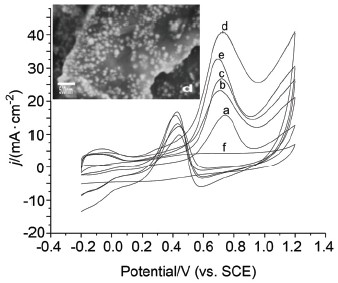| [1] Li, Y. M.; Tang, L. H.; Li, J. H. Electrochem. Commun. 2009, 11, 846. [2] Ye, W. C.; Kou, H. H.; Liu, Q. Z. Int. J. Hydrogen Energy 2012, 37, 4088. [3] Zhang, H. M.; Zhou, W. Q.; Du, Y. K.; Yang, P.; Xu, J. K. Acta Chim. Sinica 2010, 68, 2529. (张红梅, 周卫强, 杜玉扣, 杨平, 徐景坤, 化学学报, 2010, 68, 2529.) [4] Wang, Z. H.; Chen, T. W.; Li, J.; Wang, D.; Qiao, H. Y.; Huang, A.-P. Acta Chim. Sinica 2009, 67, 392. (汪振辉, 陈体伟, 李晶, 王栋, 乔海燕, 黄爱平, 化学学报, 2009, 67, 392.) [5] Zhou, Y. H.; Cen, S. Q.; Li, Z. L.; Niu, Z. J. Acta Chim. Sinica 2007, 65, 2669. (周颖华, 岑树琼, 李则林, 牛振江, 化学学报, 2007, 65, 2669.) [6] Sauda, T.; Ogiwara, N.; Takasu, Y.; Sugimoto, W. J. Phys. Chem. C 2010, 114, 13390. [7] Lee,Y. H.; Lee, G.; Shim, J. H.; Hwang, S.; Kwak, J.; Lee, K.; Song, H.; Park, J.-T. Chem. Mater. 2006, 18, 4209. [8] Wang, S. Y.; Wang, X.; Jiang S. P. Langmuir 2008, 24, 10505. [9] Liu, S. H.; Yu, W. Y.; Chen, C. H.; Lo, A. Y.; Hwang, B. J.; Chien, S. H.; Liu, S. B. Chem. Mater. 2008, 20, 1622. [10] Liu, Z. L.; Su, F. B.; Zhang, X. H.; Tay, S. W. ACS Appl. Mater. Interfaces 2011, 3, 3824. [11] Xu, J. B.; Hua, K. F.; Sun, G. Z.; Wang, C. Electrochem. Commun. 2006, 8, 982. [12] Sandoval Gonzalez, A.; Borja Arco, E.; Escalante, J. Int. J. Hydrogen Energy 2012, 37, 1052. [13] Wakisaka, M.; Mitsui, S.; Hirose, Y.; Kawashima, K.; Uchida, H.; Watanabe, M. J. Phys. Chem. B 2006, 110, 23489. [14] Prabhuram, J.; Zhao, T. S.; Tang, Z. K.; Chen, R.; Liang, Z. X. J. Phys. Chem. B 2006, 110, 5245. [15] Wu, G.; Swaidan, R.; Li, D.; Li. N. Electrochim. Acta 2008, 53, 7622. [16] Hernández-Fernández, P.; Nuño, R.; Fatás, E. Int. J. Hydrogen Energy 2011, 36, 8267. [17] Kakati, N.; Maiti, J.; Jee, S. H.; Lee, S. H.; Yoon, Y. S. J. Alloys Compd. 2011, 509, 5617. [18] Kim, C.; Kwon, H. H.; Song, I. K.; Sung, Y. E.; Chung, W. S.; Lee, H. I. J. Power Sources 2007, 171, 404. [19] Rozhkov, A. V.; Giavaras, G.; Bliokh, Y. P.; Freilikher, V.; Nori, F. Phys. Rev. 2011, 53, 77. [20] Xu, C. W.; Su, Y. Z.; Tan, L. L.; Liu, Z. L. Electrochim. Acta 2009, 54, 6322. [21] Li, Y. J.; Gao, W;. Ci, L. J.; Wang, C. M. Carbon 2010, 48, 1129. [22] Sharma, S.; Ganguly, A.; Papakonstantinou, P.; Miao, X.-P.; Li, M.-X. J. Phys. Chem. C 2010, 114, 19464. [23] Wietechaa, M.; Zhu, J.; Gao, G.-H.; Wang, N. J. Power Sources 2012, 198, 34. [24] Niu, L.; Li, Q. H.; Wei, F. H.; Chen, X.; Wang, H. Synth. Met. 2003, 139, 271. [25] Søgaard, M.; Odgaard, M.; Skou, E. M. Solid State Ionics 2001, 145, 31. [26] Hamnett, A. Catal. Today 1997, 38, 445. [27] Baldauf, M.; Preidel, W. J. Power Sources 1999, 84, 162. [28] Huang, Y. Y.; Zheng, S. Y.; Lin, X. Z.; Su, L. Q.; Guo, Y. L. Electrochim. Acta 2012, 63, 346. [29] Ye, W. C.; Kou, H. H.; Liu, Q. Z. Int. J. Hydrogen Energy 2012, 37, 4096. [30] Nicholson, R. S.; Shain, I. Anal. Chem. 1964, 36, 706. [31] Wu, G.; Li, L.; Xu, B. Q. Electrochim. Acta 2004, 50, 7. [32] Wang, Z. B.; Yin, Z. P.; Shao, Y. Y. J. Power Sources 2007, 165, 9. [33] Laviron, E.; Roullier, L. J. Electroanal. Chem. 1980, 115, 65. [34] Khan, A. S. A.; Ahmed, R.; Mirza, M. L. Turk. J. Chem. 2008, 32, 750. [35] Wang, Z. H.; Xia, J. F.; Zhu, L. Y.; Zhang, F. F. Sens. Actuators B-Chem. 2012, 161, 133. |
